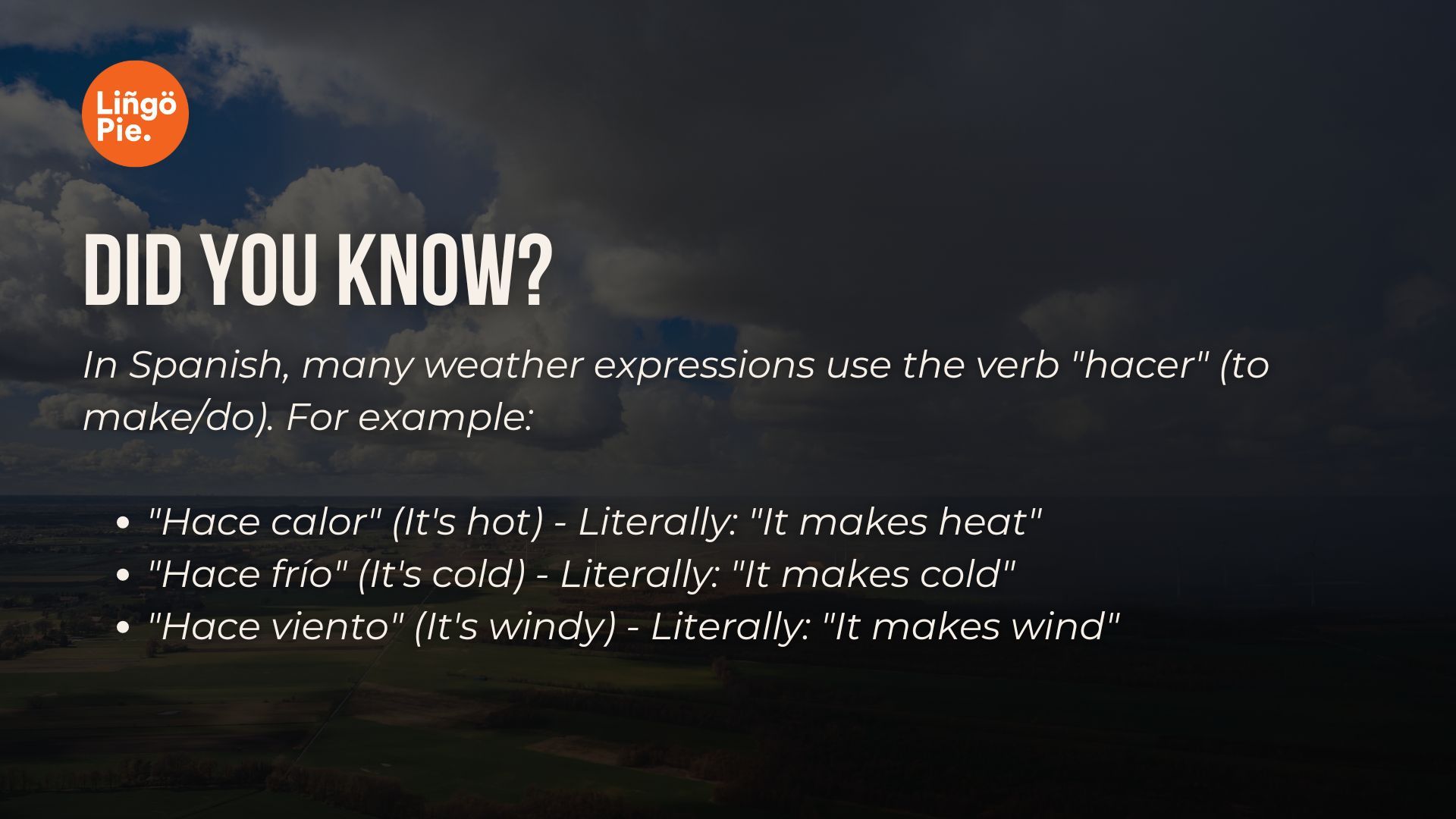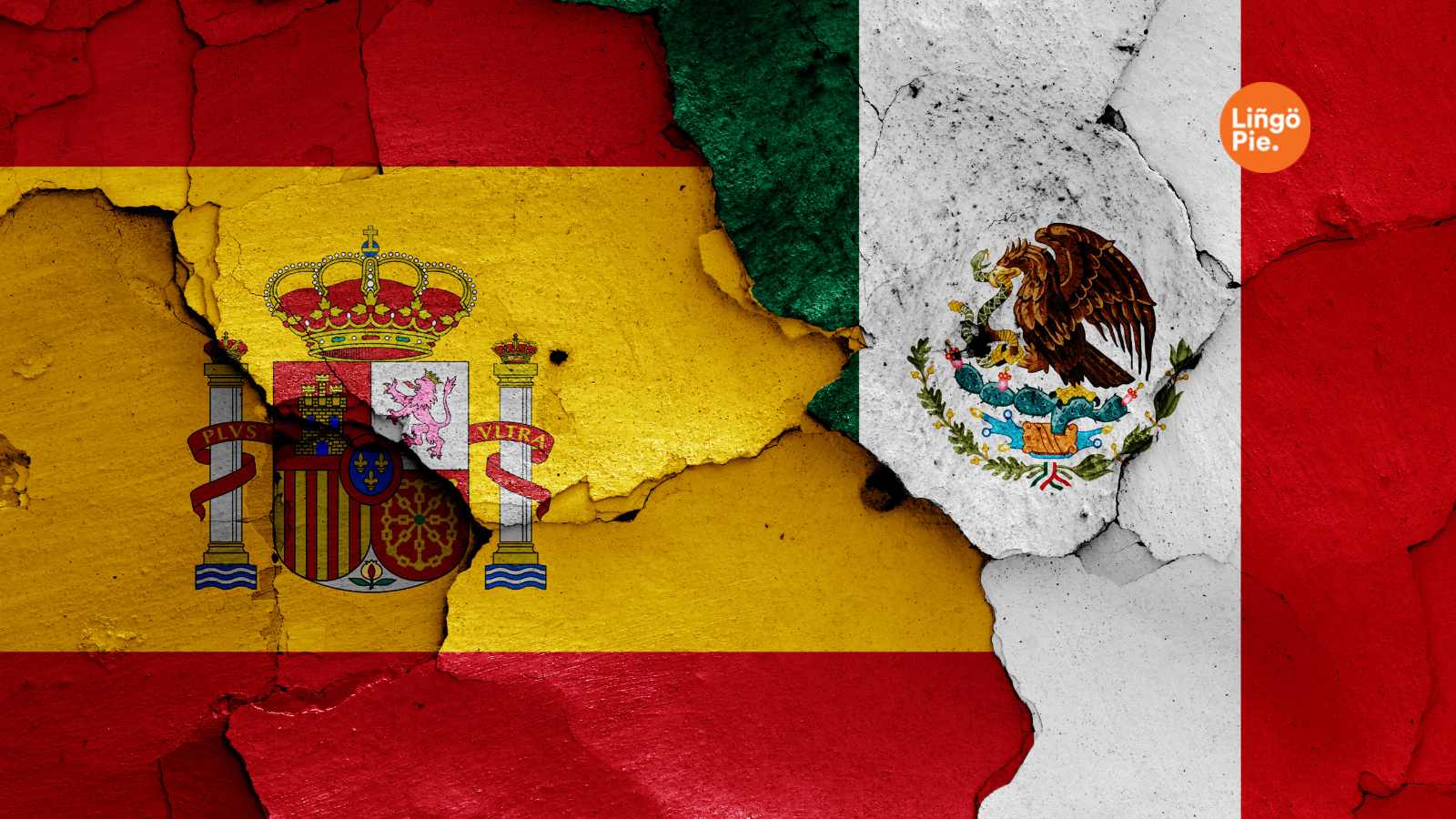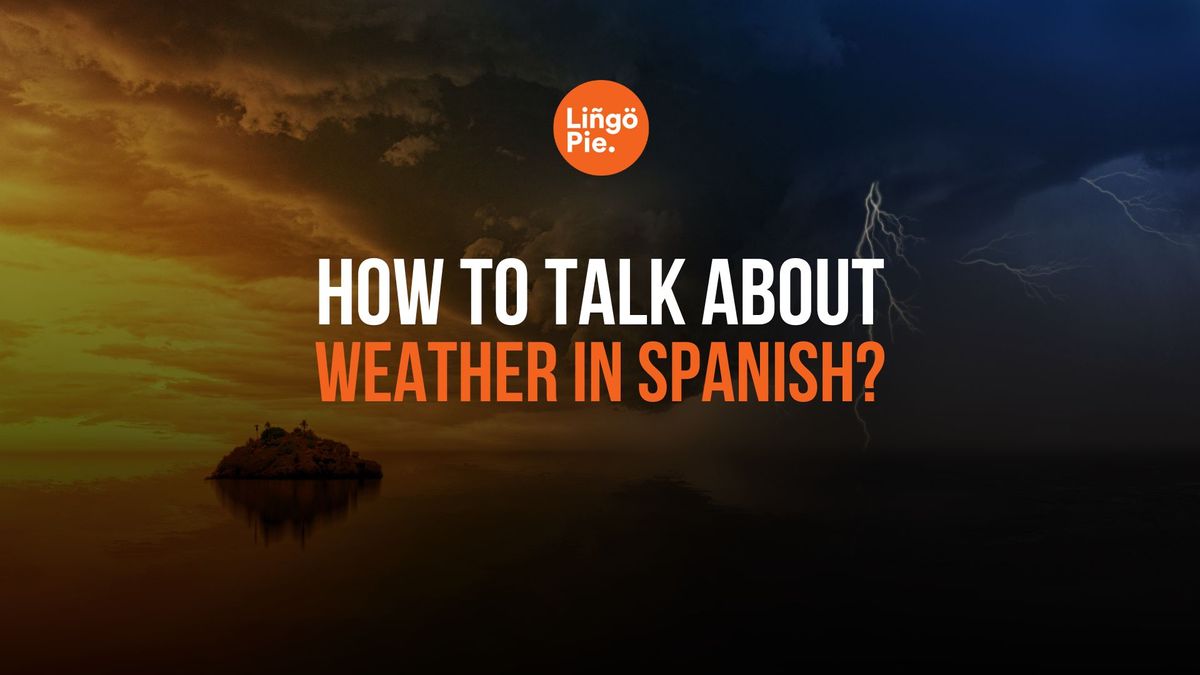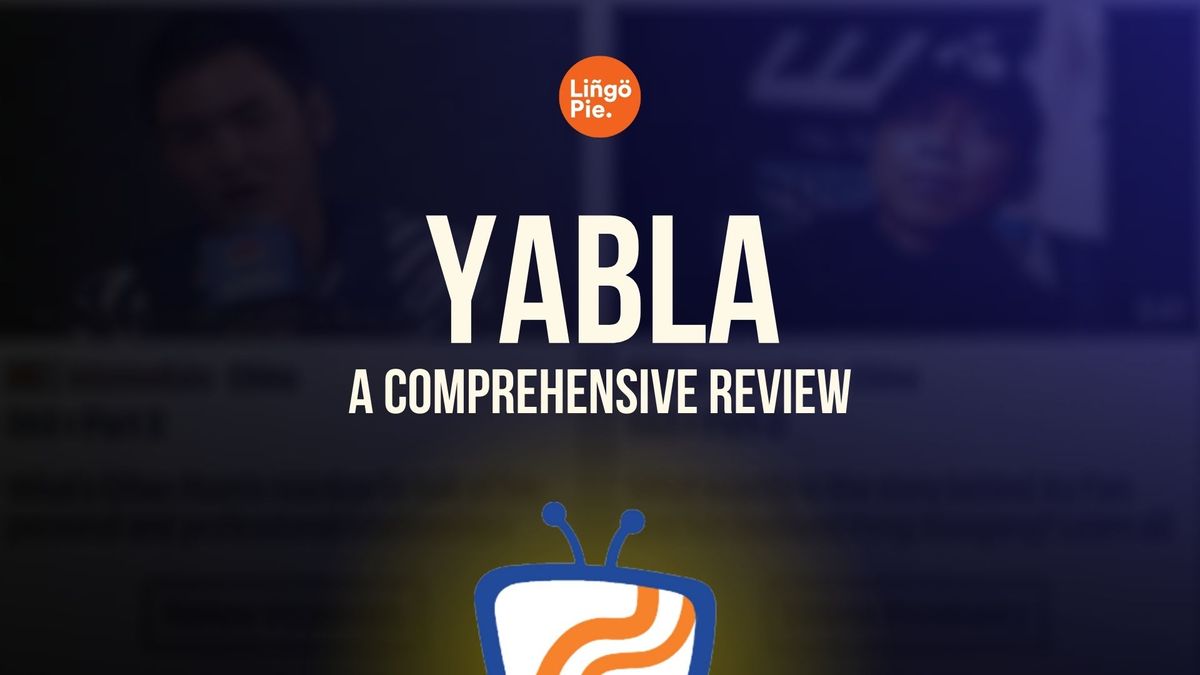There I was, fresh off the plane in Madrid, armed with nothing but a pocket-sized notebook filled with Spanish travel phrases and a dream. My first interaction? A friendly taxi driver who greeted me with a rapid-fire string of Spanish that left me blinking in confusion. But then I caught one word I recognized: "calor" (hot).
Suddenly, I had my in. "Sí, mucho calor," I replied, probably butchering the pronunciation but hey, I was trying! At the same time, that simple interaction made me realize one thing: Talking about the weather is a universal icebreaker.
Think about it: how many times have you bonded with a stranger over a sudden downpour, or commiserated with coworkers about a heatwave? It's our go-to conversation starter, our social safety net when we're caught in those awkward silences.
So, in this blog post, I'll teach you how to easily talk about the weather in Spanish! By the end of this post, you'll be breezing through Spanish weather conversations like a pro. Let's begin!

Basic Weather Vocabulary In Spanish
By learning this basic weather vocabulary, you can easily start talking about the weather in Spanish. For example, you can understand it the next time Mexican vloggers say "El clima está soleado" (The weather is sunny) or "Hace frío hoy" (It is cold today).
| Spanish | English |
|---|---|
| El clima | The climate |
| El tiempo | The weather |
| Soleado | Sunny |
| Lluvioso | Rainy |
| Nublado | Cloudy |
| Calor | Heat |
| Frío | Cold |
Now, let's put these words to work! After all, knowing the words is one thing, but using them in a sentence? That's where the magic happens. Here are some easy-peasy phrases to get you started:
- "El clima está soleado hoy." (The weather is sunny today.)
- "¡Qué tiempo tan lluvioso!" (What rainy weather!)
- "El cielo está muy nublado." (The sky is very cloudy.)
- "Hace mucho calor aquí." (It's very hot here.)
- "¡Qué frío hace esta mañana!" (How cold it is this morning!)
Pro tip: Notice how we use "hace" (it makes) with "calor" and "frío"? That's a little Spanish quirk to keep in mind. We don't say "es calor" (it is hot), but "hace calor" (it makes heat).

Phrases And Expressions About Weather In Spanish
These common phrases and expressions will help you have weather-related conversations with ease. Plus, they can also help you appreciate some Spanish songs that use weather words as metaphors. For example, you can ask someone “¿Qué tiempo hace?” and respond with “Hace sol” or “Está lloviendo” depending on the current weather.
| Spanish | English |
|---|---|
| ¿Qué tiempo hace? | What’s the weather like? |
| ¿Cómo está el clima? | How’s the weather? |
| Hace sol | It’s sunny. |
| Está lloviendo | It’s raining. |
| Hace calor | It’s hot. |
| Hace frío | It’s cold. |
| Está nublado | It’s cloudy. |
| Hace viento | It’s windy. |
| Está nevando | It’s snowing. |
| Hace buen tiempo | The weather is nice. |
| Hace mal tiempo | The weather is bad. |
Seasonal Weather Terms In Spanish
By learning these seasonal weather terms, you can describe the typical weather conditions for each time of the year. For example, during verano you might say "Hace calor y está soleado" (It's hot and sunny), while in invierno you could describe the weather as "Está nevando y hace frío" (It's snowing and cold).
Here's a handy table of weather terms for each season in Spanish. Don't worry if it looks like a lot - we'll break it down and make it super easy!
| Season (Spanish) | Season (English) | Weather Term | English Translation | Example Sentence | English Translation |
|---|---|---|---|---|---|
| Verano | Summer | Caluroso | Hot | Hoy está caluroso | It's hot today |
| Soleado | Sunny | El día está soleado | The day is sunny | ||
| Húmedo | Humid | El verano es húmedo aquí | Summer is humid here | ||
| Bochornoso | Muggy | Qué tiempo tan bochornoso | What muggy weather | ||
| Invierno | Winter | Frío | Cold | Hace frío hoy | It's cold today |
| Nevado | Snowy | El paisaje está nevado | The landscape is snowy | ||
| Helado | Icy | Cuidado, el suelo está helado | Be careful, the ground is icy | ||
| Ventoso | Windy | Es un día ventoso | It's a windy day | ||
| Primavera | Spring | Templado | Mild | La primavera es templada | Spring is mild |
| Lluvioso | Rainy | Abril es lluvioso | April is rainy | ||
| Flores* | Flowers | Las flores están floreciendo | The flowers are blooming | ||
| Despejado | Clear | El cielo está despejado | The sky is clear | ||
| Otoño | Autumn/Fall | Fresco | Cool | Las noches son frescas en otoño | The nights are cool in autumn |
| Nublado | Cloudy | Hoy está nublado | It's cloudy today | ||
| Ventoso | Windy | El otoño puede ser ventoso | Autumn can be windy | ||
| Lluvioso | Rainy | Es un otoño lluvioso | It's a rainy autumn |
Notice how we use "está" for temporary conditions (like today's weather) and "es" for more general statements? That's a little Spanish quirk to keep in mind!
Now you're ready to talk about weather all year round in Spanish. Try making your own sentences using these terms. Before you know it, you'll be chatting about the seasons like a pro. ¡Buena suerte! (Good luck!)

Advanced Weather Vocabulary In Spanish
These advanced weather terms and idiomatic expressions will enrich your Spanish vocabulary and enable you to describe and discuss weather conditions more precisely.
For example, you can say "Hay una tormenta con relámpagos y truenos" (There is a storm with lightning and thunder) or use an idiom like "Hoy está lloviendo a cántaros" (Today it's raining heavily) to sound more like a native speaker.
Weather Conditions In Spanish
| Spanish | English |
|---|---|
| Tormenta | Storm |
| Huracán | Hurricane |
| Chubasco | Heavy rain shower |
| Granizo | Hail |
| Ráfaga | Gust of wind |
| Inundación | Flood |
| Sequía | Drought |
| Relámpago | Lightning |
| Trueno | Thunder |
Idiomatic Expressions Related To Weather In Spanish
| Spanish | English |
|---|---|
| Estar en las nubes | To be daydreaming (literally, "to be in the clouds") |
| Llover a cántaros | To rain heavily (literally, "to rain jugs") |
| Hacer un tiempo de perros | To be awful weather (literally, "to make a dog's weather") |
| Estar como una sopa | To be soaked (literally, "to be like a soup") |
| Ser un sol | To be a lovely person (literally, "to be a sun") |
| Hacer un sol de justicia | To be extremely hot (literally, "to make a sun of justice") |

Sample Spanish Dialogues To Practice Weather Conversations
Dialogue 1: Discussing Today’s Weather
- Person A: ¿Qué tiempo hace hoy?
- Person B: Hace sol y calor. ¿Y en tu ciudad?
- Person A: Aquí está nublado y hace un poco de frío.
Dialogue 2: Planning for the Weekend
- Person A: ¿Qué planes tienes para el fin de semana?
- Person B: Depende del clima. ¿Sabes qué tiempo hará?
- Person A: Creo que va a llover el sábado, pero el domingo estará soleado.
Dialogue 3: Talking About Seasonal Weather
- Person A: ¿Te gusta el clima de verano?
- Person B: Sí, me encanta cuando hace calor y puedo ir a la playa. ¿Y a ti?
- Person A: Prefiero la primavera, cuando está templado y las flores están en su esplendor.
Dialogue 4: Tourist Asking About the Weather
- Tourist: Disculpe, ¿puede decirme cómo estará el tiempo mañana?
- Local: Claro, mañana estará soleado y hará unos 25 grados. Perfecto para visitar la ciudad.
Dialogue 5: Friends Discussing a Picnic
- Friend A: ¿Vamos a hacer un picnic este fin de semana?
- Friend B: Buena idea, pero debemos verificar el clima primero.
- Friend A: Según el pronóstico, el sábado habrá chubascos, pero el domingo estará despejado.
Dialogue 6: Preparing for a Trip
- Traveler: Estoy empacando para mi viaje a Madrid. ¿Qué tipo de ropa debería llevar?
- Local: En esta época del año, el clima es impredecible. Te recomiendo llevar ropa ligera para el día, pero también un suéter para la noche, ya que puede hacer frío.
Dialogue 7: Discussing Weather Extremes
- Person A: ¿Alguna vez has estado en una tormenta de nieve?
- Person B: Sí, el invierno pasado fue muy frío y nevó mucho. Fue difícil salir de casa.
- Person A: ¡Qué experiencia! Aquí solo tenemos lluvias intensas en verano y ocasionalmente huracanes.
Tips For Learning Weather Vocabulary
1. Using Flashcards And Apps
Flashcards: Create flashcards with weather terms and phrases. On one side, write the word in Spanish, and on the other side, include a picture or the English translation. Regularly review these flashcards to reinforce your memory.
Language Learning Apps: Utilize apps like Duolingo, Anki, or Memrise, which often include weather vocabulary in their lessons. These apps offer interactive exercises and spaced repetition to help you retain new words effectively.
2. Listening To Weather Reports ın Spanish
Spanish News Channels: Tune into Spanish news channels like Univision or Telemundo, which provide regular weather updates. Listening to these reports will help you hear weather vocabulary in context and improve your listening comprehension.
Online Weather Forecasts: Visit websites like AccuWeather or BBC Weather in Spanish. Reading and listening to the forecasts can help you familiarize yourself with the terms and their usage.
Podcasts And Radio: Find Spanish-language podcasts or radio stations that include weather segments. This exposure will enhance your understanding and pronunciation of weather-related vocabulary.
3. Engaging In Conversations With Native Speakers
Language Exchange Partners: Connect with native Spanish speakers through language exchange platforms like Tandem or HelloTalk. Practice talking about the weather in your daily conversations.
Spanish Classes: Participate in Spanish classes or conversation groups where you can discuss various topics, including the weather, with teachers and fellow learners.
Social Media: Follow Spanish-speaking influencers or weather channels on social media. Engage with their content by leaving comments or asking questions about the weather, which will give you practical practice.
Final Words
Mastering weather-related vocabulary and expressions in Spanish is a fundamental step towards achieving fluency and engaging in meaningful conversations. Whether you're asking about the weather, describing current conditions, or discussing seasonal changes, being able to talk about the weather enhances your ability to connect with native speakers and navigate everyday situations.
Learn Spanish by Watching Movies through Lingopie!
Who says learning Spanish can’t be fun? Grab your favorite snacks and binge-watch Spanish TV shows and movies to learn Spanish. That's the mission of Lingopie, making language learning fun and immersive!
Lingopie makes learning a new language fun and effective by using real TV shows, movies, and documentaries. It offers interactive subtitles, so you can click on any word to get an instant translation and pronunciation. If this sounds fun to you, download Lingopie from the App Store or Play Store now and get a FREE 7-day trial!
Frequently Asked Questions
1. How to tell about the weather in Spanish?
To tell about the weather in Spanish, use phrases like "Hace sol" (It's sunny), "Está lloviendo" (It's raining), or "Hace frío" (It's cold). These simple expressions describe the current weather conditions.
2. What are 5 weather expressions in Spanish?
- Hace sol. (It's sunny.)
- Está nublado. (It's cloudy.)
- Hace calor. (It's hot.)
- Está nevando. (It's snowing.)
- Hace viento. (It's windy.)
3. How to talk about the weather in the past in Spanish?
To talk about the weather in the past, use the imperfect tense. For example, "Ayer hacía sol" (Yesterday, it was sunny) or "La semana pasada, estaba lloviendo" (Last week, it was raining).
4. What are the questions about the weather in Spanish?
- ¿Qué tiempo hace? (What's the weather like?)
- ¿Cómo está el clima? (How's the weather?)
- ¿Hace frío hoy? (Is it cold today?)
- ¿Va a llover mañana? (Is it going to rain tomorrow?)
- ¿Cómo estuvo el clima ayer? (How was the weather yesterday?)








![Are You A Gabacho, Gringo, Or Güero? [Spanish Slang Guide]](/blog/content/images/size/w300/2025/06/Gabacho-Meaning.jpg)

